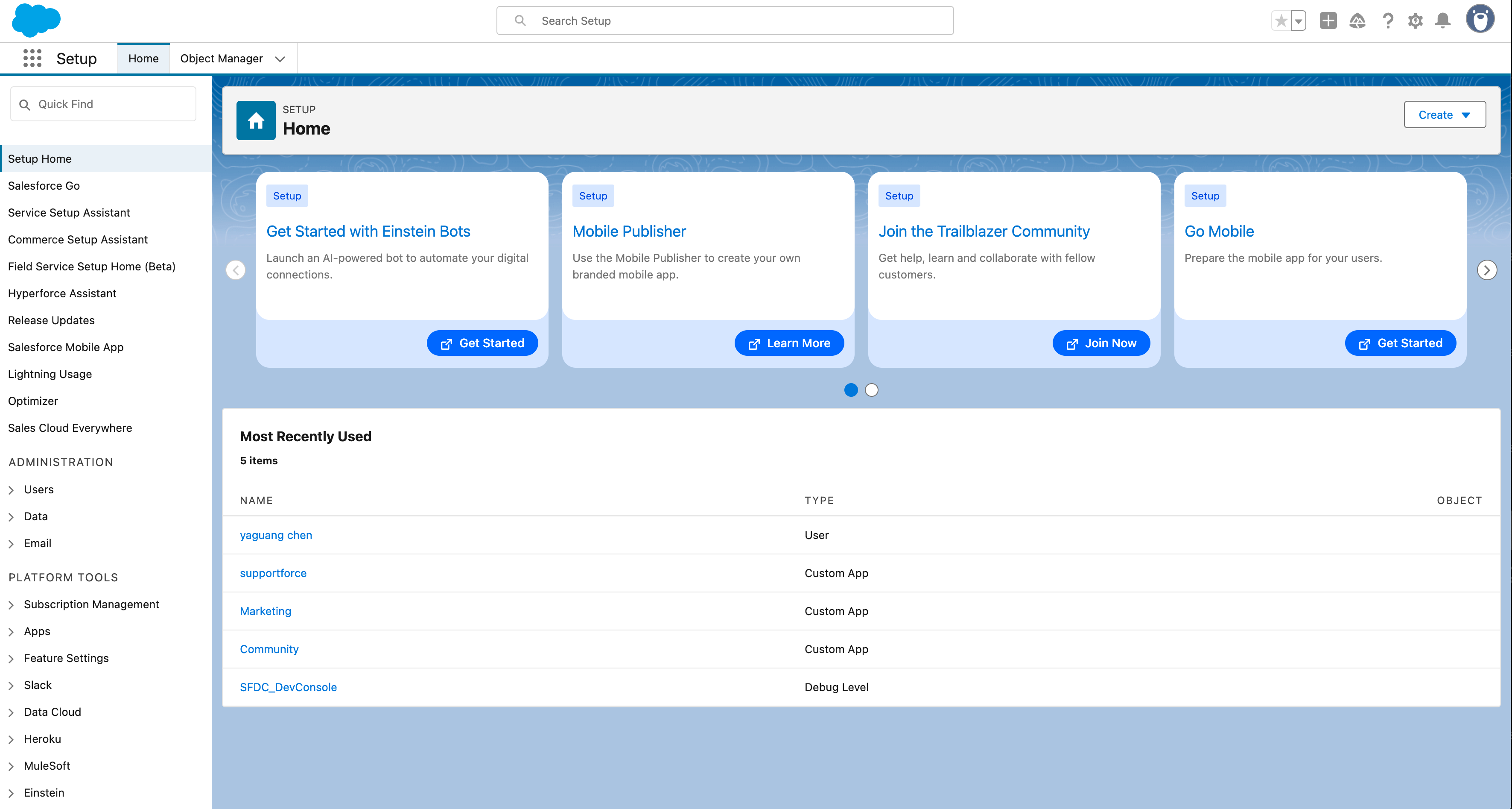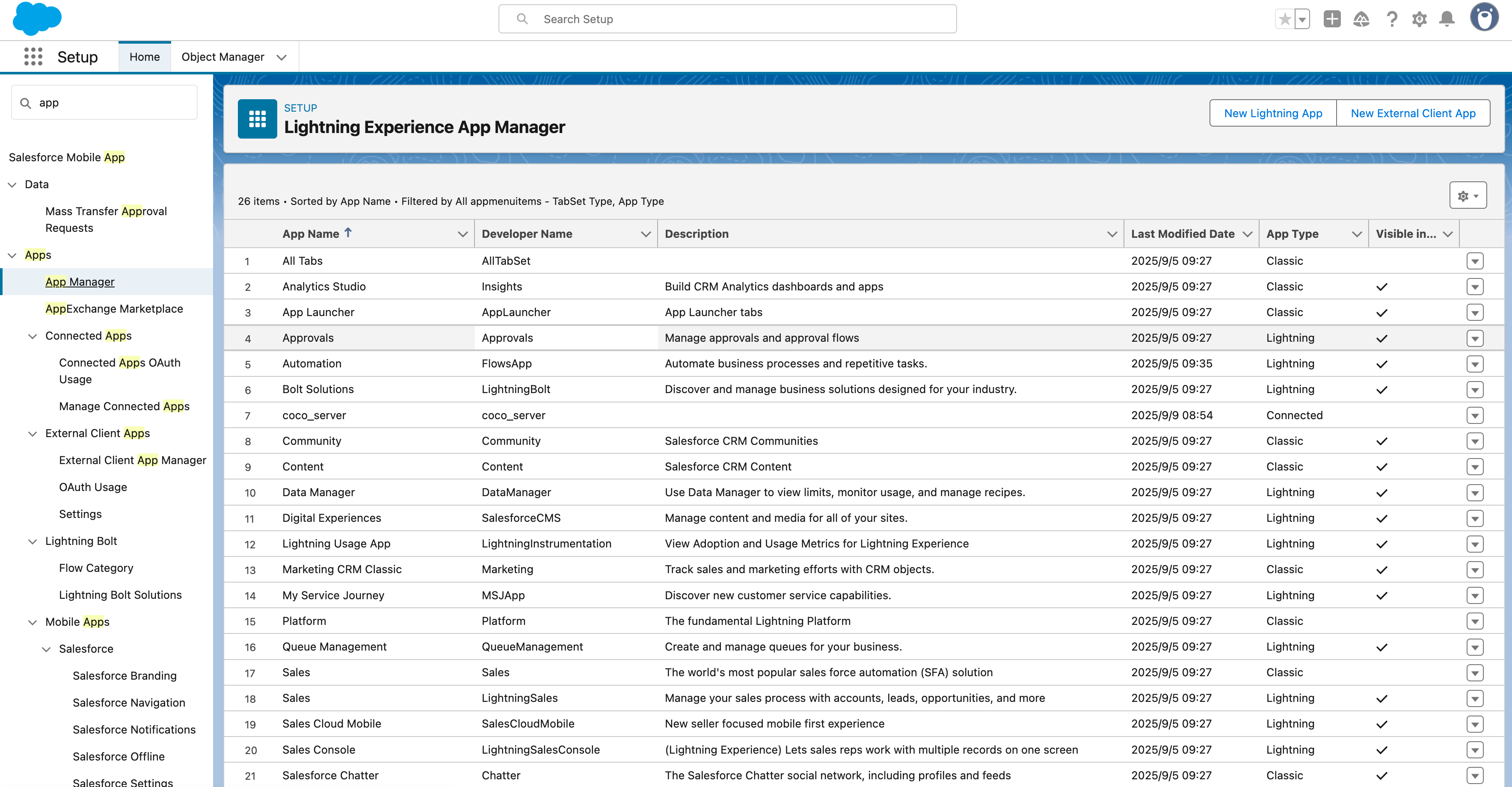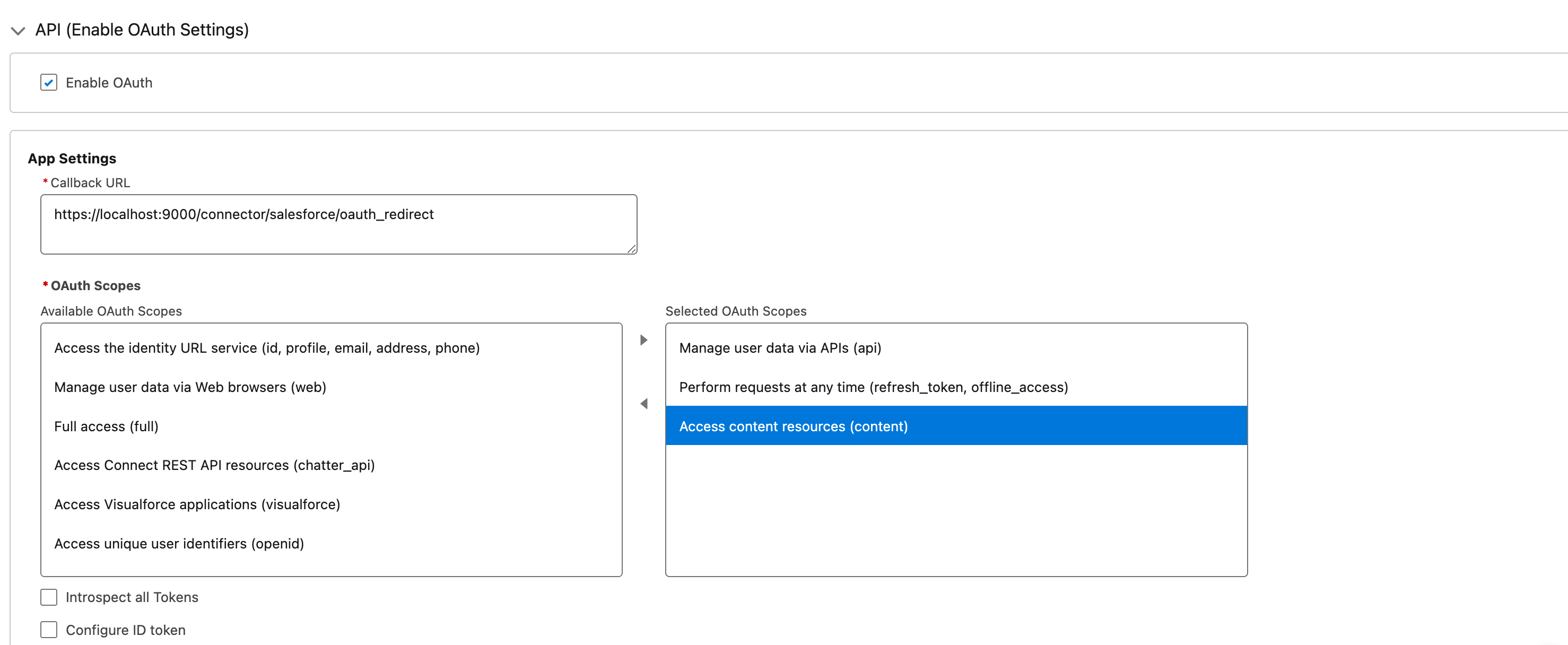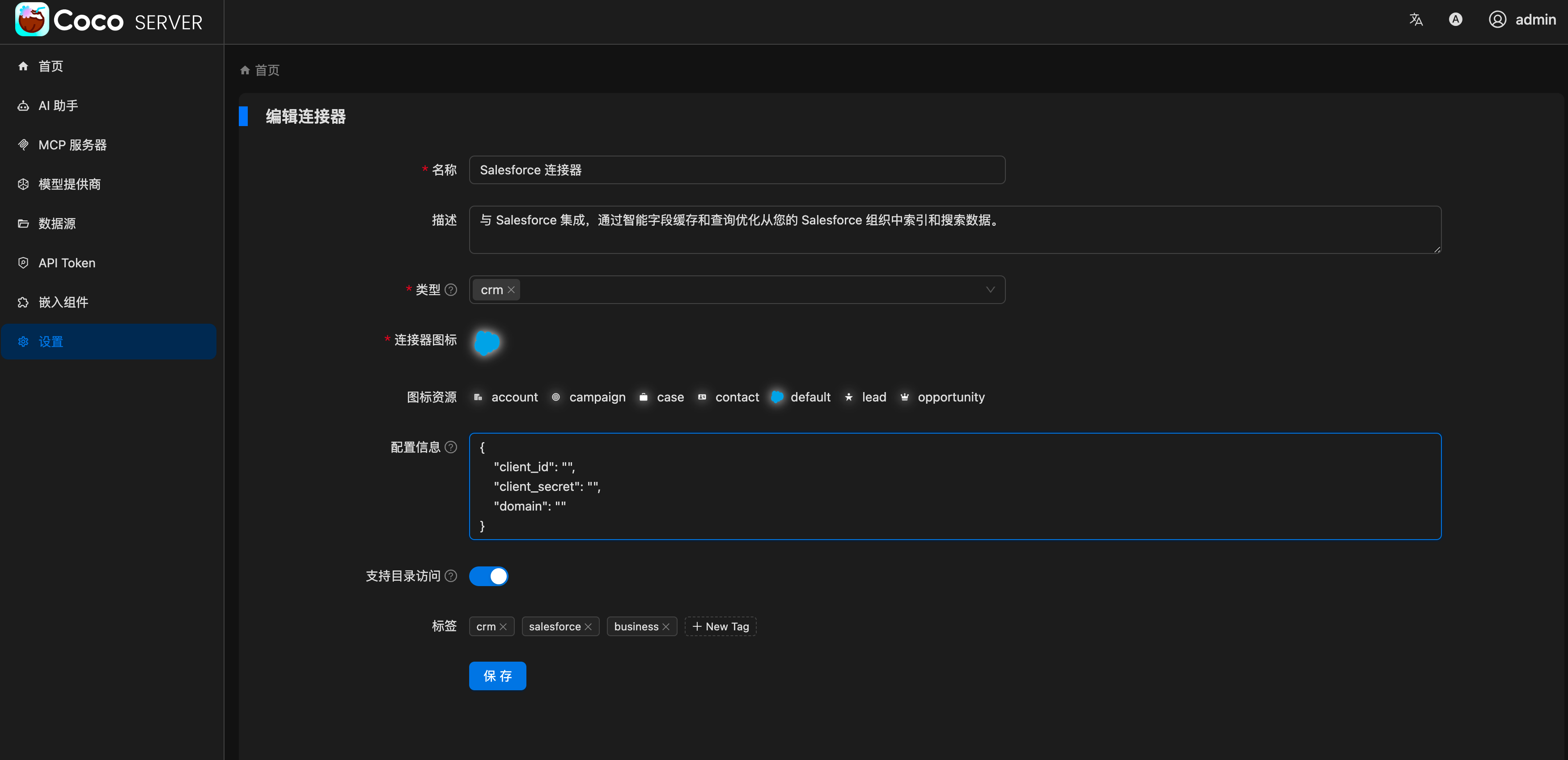Salesforce Connector #
Register Salesforce Connector #
curl -XPOST "http://localhost:9000/connector/" -d '{
"name": "Salesforce Connector",
"description": "Fetch data from Salesforce with intelligent field caching and query optimization.",
"icon": "/assets/icons/connector/salesforce/icon.png",
"category": "crm",
"tags": [
"salesforce",
"crm",
"api",
"oauth"
],
"url": "http://coco.rs/connectors/salesforce",
"assets": {
"icons": {
"default": "/assets/icons/connector/salesforce/icon.png",
"account": "/assets/icons/connector/salesforce/account.png",
"opportunity": "/assets/icons/connector/salesforce/opportunity.png",
"contact": "/assets/icons/connector/salesforce/contact.png",
"lead": "/assets/icons/connector/salesforce/lead.png",
"campaign": "/assets/icons/connector/salesforce/campaign.png",
"case": "/assets/icons/connector/salesforce/case.png"
}
},
"processor": {
"enabled": true,
"name": "salesforce"
}
}'
Use the Salesforce Connector #
The Salesforce Connector allows you to index data from your Salesforce org with intelligent field caching, query optimization, and comprehensive data extraction.
Features #
- OAuth2 Client Credentials Flow: Secure server-to-server authentication
- Intelligent Field Caching: Caches queryable objects and fields to optimize API calls
- Query Optimization: Automatically filters fields to only query accessible ones
- Standard Objects Support: Indexes standard Salesforce objects (Account, Opportunity, Contact, Lead, Campaign, Case)
- Custom Objects Support: Can index custom objects with the
__csuffix - Case Feeds Integration: Automatically includes related Case Feeds for comprehensive Case data
- Content Document Links: Includes attached files and documents in SOQL queries
- Relationship Fields: Supports querying relationship fields like Owner.Id, Owner.Name, Owner.Email
- Configurable Content Extraction: Flexible content field mapping for different object types
- Directory Access Support: Hierarchical directory structure for browsing Salesforce data by SObject type
Setup Salesforce Connected App #
Before using this connector, you need to create a Salesforce Connected App and configure OAuth2 Client Credentials Flow.
1. Create a Salesforce Connected App #
- Log in to your Salesforce org

- Go to Setup > App Manager

Click “New External Client App”
Fill in the required fields:
- External Client App Name: “Coco Connector”
- Api Name: “Coco_Connector”
- Contact Email: your email

- Enable OAuth Settings:
- Callback URL
- Selected OAuth Scopes:
- Manage user data via APIs (api)
- Perform requests at any time (refresh_token, offline_access)
- Access content resources (content)

- Enable Client Credentials Flow (Important):
- Check “Enable Client Credentials Flow”
- This allows server-to-server authentication without user interaction

Save the connected app
Note down the Consumer Key (Client ID) and Consumer Secret (Client Secret)

2. Enable Client Credentials User (if needed) #
- Go to Setup > Users > Permission Sets
- Create a new Permission Set or use an existing one
- Add the following permissions:
- API Enabled
- View All Data (if needed)
- Modify All Data (if needed)
- Go to Setup > Users > Users
- Find the user you want to use for the connector
- Click “Edit” next to the user
- Go to “Permission Set Assignments”
- Assign the permission set created above
3. Enable Client Credentials Flow #
- Enable “Client Credentials Flow” for this user:
- Go to Setup > App Manager > Your Connected App
- In the “Run As (Username)” section, assign the user
- Ensure the user is active and has API access

Access Connector Settings #
- Navigate to the Data Sources section in your Coco dashboard
- Find the Salesforce data source you want to configure
- Click the Edit button (pencil icon) next to the data source
- This will open the configuration page where you can:
- Modify which Salesforce objects to sync
- Enable or disable custom object synchronization
- Update sync settings and filters
⚠️ Important: Before you can use the Salesforce connector, you must configure the following required parameters:
domain: Your Salesforce domain (e.g., “mycompany” for mycompany.my.salesforce.com)client_id: OAuth2 client ID from your Salesforce connected appclient_secret: OAuth2 client secret from your Salesforce connected appThese credentials are obtained from the Salesforce Connected App you created in the previous steps.

Datasource Configuration #
Each datasource has its own sync configuration and object selection:
curl -H 'Content-Type: application/json' -XPOST "http://localhost:9000/datasource/" -d '{
"name": "My Salesforce Data",
"type": "connector",
"enabled": true,
"connector": {
"id": "salesforce",
"config": {
"standard_objects_to_sync": ["Account", "Opportunity", "Contact", "Lead", "Campaign", "Case"],
"sync_custom_objects": true,
"custom_objects_to_sync": ["CustomObject__c"]
}
},
"sync": {
"enabled": true,
"interval": "5m"
}
}'
Datasource Config Parameters #
| Field | Type | Description |
|---|---|---|
standard_objects_to_sync | array | List of standard objects to sync (default: all standard objects). |
sync_custom_objects | boolean | Whether to sync custom objects (default: false). |
custom_objects_to_sync | array | List of custom objects to sync (use “*” for all). |
sync.enabled | boolean | Enable/disable syncing for this datasource. |
sync.interval | string | Sync interval for this datasource (e.g., “5m”, “1h”, “30s”). |
Supported Objects #
Standard Objects #
- Account: Company information, billing addresses, contacts, website, type
- Opportunity: Sales opportunities, stages, amounts, related opportunities
- Contact: Individual contacts, email, phone, titles, owner information
- Lead: Potential customers, lead sources, conversion status, company info
- Campaign: Marketing campaigns, status, dates, campaign type
- Case: Support cases, status, descriptions, case feeds, comments, and related activities
Custom Objects #
- Any custom object with
__csuffix - Supports all custom fields and relationships
Directory Structure #
The connector creates a hierarchical directory structure for easy browsing:
Standard Objects/
├── Account/
├── Contact/
├── Lead/
├── Opportunity/
├── Case/
└── Campaign/
Custom Objects/
├── CustomObject1__c/
└── CustomObject2__c/
- First Level: SObject type groups (Standard Objects, Custom Objects)
- Second Level: Individual SObject types (Account, Contact, etc.)
- Third Level: Individual records within each SObject type
Content Extraction #
The connector intelligently extracts content based on object type:
- Account: Description, Website, Type, Billing Address
- Opportunity: Description, Stage Name
- Contact: Description, Email, Phone, Title
- Lead: Description, Company, Email, Phone, Status
- Campaign: Description, Type, Status, Active status
- Case: Description, Case Number, Status, Open/Closed status, Feeds
Advanced Features #
Intelligent Field Caching #
The connector implements intelligent field caching to optimize API performance:
- Object Caching: Caches queryable SObjects to avoid repeated API calls
- Field Caching: Caches queryable fields for each object type
- Smart Filtering: Automatically filters fields to only query accessible ones
- Error Prevention: Validates object queryability before attempting queries
Query Optimization #
The connector automatically optimizes SOQL queries:
- Field Validation: Only queries fields that exist and are accessible
- Object Validation: Checks object queryability before querying
- Dynamic Field Selection: Adapts queries based on available fields
- Relationship Fields: Automatically includes Owner and CreatedBy relationship fields
- Content Document Links: Includes attached files and documents in queries
- Error Reduction: Prevents common query errors
Case Feeds Integration #
For Case objects, the connector automatically includes related Feeds:
- Automatic Detection: Checks if CaseFeed is queryable
- Batch Processing: Processes Case Feeds in batches of 800 for performance
- Feed Grouping: Groups feeds by ParentId (Case ID)
- Comprehensive Data: Includes feed comments, activities, and related content
- Performance Optimized: Reduces API calls through intelligent batching
SOQL Query Builder #
The connector uses a fluent SOQL query builder for complex queries:
- Fluent API: Chainable methods for building queries
- Field Management: Automatic field deduplication and ordering
- Join Support: Built-in support for subqueries and joins
- Conditional Logic: Support for WHERE, ORDER BY, and LIMIT clauses
Directory Access #
The connector supports hierarchical directory access for easy data browsing:
- Automatic Directory Creation: Creates directory structure based on SObject types
- Hierarchical Navigation: Browse data by SObject type groups and individual types
- Metadata Support: Each directory includes metadata about SObject types
- Path-based Access: Use directory paths to access specific SObject data
- Standard vs Custom Objects: Clear separation between standard and custom objects
Directory Features #
- Root Level: No root directory - direct access to SObject type groups
- Type Grouping: Standard Objects and Custom Objects are grouped separately
- Individual SObject Types: Each SObject type gets its own directory
- Record Organization: Individual records are organized under their respective SObject type directories
- Metadata: Directories include SObject type information and access metadata
Supported Config Parameters for Salesforce Connector #
Below are the configuration parameters supported by the Salesforce Connector:
| Field | Type | Description |
|---|---|---|
standard_objects_to_sync | array | List of standard objects to sync (default: all standard objects). |
sync_custom_objects | boolean | Whether to sync custom objects (default: false). |
custom_objects_to_sync | array | List of custom objects to sync (use “*” for all). |
Troubleshooting #
Common Issues #
“no client credentials user enabled” Error:
- Cause: Client Credentials Flow is not enabled or no user is assigned for client credentials
- Solution:
- Go to Setup > App Manager > Your Connected App
- Check “Enable Client Credentials Flow”
- Assign a user to the Client Credentials Flow
- Ensure the user has API access and necessary permissions
“invalid_client” Error:
- Cause: Incorrect client_id or client_secret
- Solution: Verify your Consumer Key (Client ID) and Consumer Secret (Client Secret) in the Connected App
“invalid_grant” Error:
- Cause: Authentication grant is invalid
- Solution: Check that the user assigned to Client Credentials Flow is active and has proper permissions
Authentication Failed: Check your client_id and client_secret
Permission Denied: Ensure your connected app has the necessary OAuth scopes
Object Not Found: Verify the object name and that it exists in your org
Field Not Accessible: Check field-level security settings in Salesforce
Notes #
- The connector uses OAuth2 Client Credentials Flow for server-to-server authentication
- Field caching significantly reduces API calls and improves performance
- Case Feeds are automatically included for Case objects when available
- Custom objects must have the
__csuffix to be recognized - The connector supports incremental synchronization based on LastModifiedDate